
Worksheet to evaluate the components of a political cartoon.
- Provider:
- Cartoons for the Classroom
- Date Added:
- 06/24/2019

Worksheet to evaluate the components of a political cartoon.
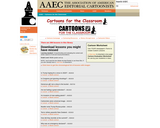
This webpage has approximately 300 political cartoons and lessons for classroom use covering an variety of current events. Each cartoon has talking points, a blank cartoon students can caption and additional resources. Note* This lesson works well with the following cartoon evaluation resource (Cartoon Evaluation Worksheet): http://nieonline.com/cftc/pdfs/eval.pdf

In this lesson, students will confirm, negate, and build information about the nation’s changing demographic using an organizational chart; write a letter to respond to a viewpoint offered in the central text; and talk about their own multiple identities in relation to those around them.
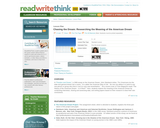
In "Paradox and Dream," a 1966 essay on the American Dream, John Steinbeck writes, "For Americans too the wide and general dream has a name. It is called "the American Way of Life.' No one can define it or point to any one person or group who lives it, but it is very real nevertheless." Yet a recent cover of Time Magazine reads "The History of the American Dream " Is It Real?" Here, students explore the meaning of the American Dream by conducting interviews, sharing and assessing data, and writing papers based on their research to draw their own conclusions.
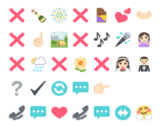
This is a lesson on tone.

In this lesson plan, students will read "The Overseer" and analyze how specific words and phrases impact the development of ideas in the text.

Students share opinions about the tone and content of two commercials presented during the Super Bowl.They then work with a partner to critique a commercial from a past Super Bowl, and then assess the commercials that run during a half-hour television show.

This lesson looks at Thomas Paine and at some of the ideas presented in his pamphlet, "Common Sense,"Â such as national unity, natural rights, the illegitimacy of the monarchy and of hereditary aristocracy, and the necessity for independence and the revolutionary struggle.

These docmument based questions and essay prompt provide the student with an in-depth opportunity to evaluate the concepts behind capitalism and communism using primary sources. Selections are taken from: Friedrich Engels, Ralph Waldo Emerson, Adam Smith, Karl Marx and others.

In this structured discussion method, under the guidance of a facilitator, participants are encouraged to engage intellectually with challenging materials, gain insight about their own point of view and strive for a shared understanding of issues. In this conversation, students will focus their study on the "Syrian Refuge Crisis and U.S. Policy."

Students participate in activities in which they learn about redistricting, types of legislative committees, types of legislation, and the process by which a bill becomes a law in Congress. Students will apply their knowledge by participating in a legislative simulation in which the House Judiciary Committee determines whether to report a proposed bill regarding punishment for drunk driving as favorable on the floor.
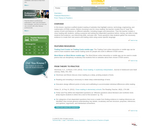
In this lesson, teachers scaffold student reading of websites that highlight science, technology, engineering, and mathematics careers. Before choosing a text for close reading, the teacher models how to "read" the variety of texts and features of different websites, including images and interactives. Then the teacher models a close reading with students, setting a purpose and asking text-dependent questions to help students find evidence, use inferencing skills, and peer edit.

This lesson and resource engages students in a metacognition exercise about critical thinking and also practice research and informational writing skills using a collection of critical thinking quotes.

The past is often neatly partitioned in time periods and eras with generalized names meant to characterize what life was like during that time. In this multi-day lesson, students question the validity of using ?Dark Ages? to describe Europe from the fall of the Roman Empire to the Renaissance. In the process, students examine a variety of primary and secondary sources highlighting different social, political, economic, cultural, and environmental facets of life in Europe during this period.
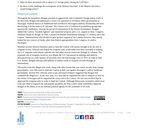
In this activity students analyze a timeline and official and unofficial documents that reveal the events of the Iran-Contra Affair. This activity also models the types of questions that can help students analyze foreign policy documents from other events. The activity instructions include suggestions for how to differentiate the activity for students with different reading levels.
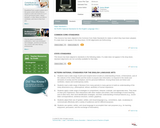
In this minilesson, students explore the dystopian characteristics and symbols presented in the "1984" Macintosh commercial and analyze the comments that it makes about contemporary society. This activity is also an effective introduction to George Orwell's 1984 because of the direct allusions to the novel in the commercial or can also be used as a follow-up.

In this lesson plan, students reveal their preconceptions about depression, then use G2C Online to learn about symptoms of the disorder, genes, and neurotransmitters associated with it, and challenges involved in diagnosis and treatment.
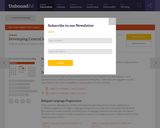
In this lesson on "Letter One" from Rilke's Letters to a Young Poet, students will analyze the development of central ideas.
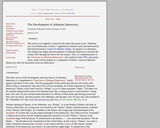
This article traces the history of government in Athens from the earliest kings to democracy. The article cites primary sources and explains the role of both Draco and Solon in the development of Athenian democracy.

In this lesson students are ask to explore ideas using examples of great writers with a particular focus on William Shakespeare. In the Introductory Activity, students look at several authors to begin identifying ways in which authors' lives are reflected in their writing. In the Learning Activity, students watch videos segments from the PBS series and explore the question of whether or not events in Shakespeare's life influenced his plays. Finally, in the Culminating Activity, students examine text from The Tempest to assert whether or not Prospero's speech from Act V, Scene 1 was in fact Shakespeare's farewell to the theatre.